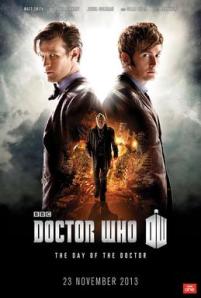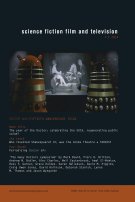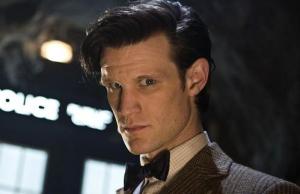
‘The Day of The Doctor’
So, a little late to the party (I do have a life beyond the Internet, you know), but here are my key takeaway points from the Doctor Who 50th anniversary special last weekend. They’re a bit rough and ready, a first stab towards profundity perhaps, but maybe someday I’ll revise them into a more coherent form! Please note: Spoilers abound here not just for ‘The Day of The Doctor’, but also, let’s face it, the entirety of space and time.
1. First off, wasn’t that brilliant? It was exciting and touching, epic and intimate, with something for modern fans as well as long-time viewers. There’ll always be people disappointed, that’s just the curiously negative nature of contemporary fandom, but I’m certainly not one of them. We got ‘appearances’ (brief though they were) from ‘classic’ Doctors, we got adventures with the contemporary incarnations, and we got mythology-shaking revelations not just about The Doctor himself but also the broad-canvass background of the show in general. ‘The Day of The Doctor’ was a triumph for Doctor Who’s ability to constantly re-invent itself. It was gorgeous to look at, nicely garnished with Easter-eggs for fans, and more than emotionally satisfying. Not bad for an hour and quarter!
2. If anyone asks me to describe this episode (or this ‘special’? This ‘film’, even?) then I’m going to say this: It’s an episode of Doctor Who about The Doctor watching an episode of Doctor Who. Some people online have complained (big surprise) that the middle section of the episode (Elizabeth I, Zygons, UNIT) didn’t feel ‘big’ enough for a 50th anniversary, that it was too much like an ‘ordinary’ episode of the show, but that’s really the point, isn’t it? John Hurt’s ‘War Doctor’, something of a surrogate for the older, grouchier ‘classic’ Doctors, is granted a glimpse of his future selves. They’re younger, yes, more superficially frivolous, to be sure, but through watching them save the world (and towards the end he’s literally sitting in an armchair watching them, as he might if he was parked in front of the TV on a Saturday evening) he is reminded of his own true nature; he’s reminded of who The Doctor is.
That this is the purpose behind ‘The Day of The Doctor’ is flagged up-front with the quotation from Marcus Aurelius by which Clara concludes her class at the beginning: “Waste no more time arguing what a good man would be… be one”. That, in a nutshell, is the final act of the anniversary special right there: No more talking, no more debate about right and wrong; just taking action and saving the day.
3. For his part, the Eleventh Doctor’s portion of the story feels like its about Doctor Who’s place in popular culture, essentially a discussion of high art versus low art. Much of his story takes place in London’s National Gallery, home of great paintings ‘from Giotto to Cézanne’, high art, in other words. But beneath it is the ‘Undergallery’ where ‘all art too dangerous for public consumption’ is held (such as the terrifically bonkers Cyberman version of the Géricault’s ‘Raft of the Medusa’). I’m reminded here of something Brian Aldis said recently at World Fantasy Con in Brighton: that critics too busy preening in the high gallery, waxing back and forth about beauty and aesthetes, ‘are afraid’ of science fiction because it has ‘this alarming power to deliver startling things’. That The Doctor was appointed by Queen Elizabeth I as curator of the Undergallery speaks to both his opposition to such figures as well as to his pre-eminence in popular culture (especially in Britain). It also speaks to the exciting and cultish (I use that term in a positive sense) aspect of Doctor Who more generally: anyone can engage with self-consciously serious high art, but it’s in the hidden, irreverent, self-contradictory art of popular culture that the excitement truly lies… and one has to seek that out for oneself.
4. The Tenth Doctor’s plotline then (and this is, admittedly, more of a stretch! But stay with me!) serves as something of a meta-story for the role of continuity in Doctor Who and, one supposes, franchise science fiction more generally. It does so by focusing on a long-running plot-thread/joke from the Tenth Doctor’s run, his frequent but never explained comments about a dalliance with Queen Elizabeth I. There’s also the appearance here of a classic monster, the shape-changing Zygons, a threat which has not been seen on screen since 1975 (‘The Terror of the Zygons’) as well as Ten’s reliance on silly gadgetry (like the ‘machine which goes ding’) and the largely set-less outdoor filming of this section. It’s true that the War Doctor is essentially a ‘classic’ take on the character, but insofar as he is metaphorically watching an episode of the show, it’s very much a story of two halves with the Tenth Doctor’s segment best reflecting the classic show’s practice of filming in, well, fields (I was almost surprised not to see a quarry), and filling scenes with extras dressed in period garb looted from the BBC costume department (by contrast, the Eleventh Doctor’s portion of the story is very much of the modern Who mold). Moreover, there is a further element here which is of relevance to the art question; the whole notion of originals Vs recreations (classic Who Vs modern Who echoed in the the painting recreating Gallifrey, the Zygons recreating Elizabeth I, and so on).
5. Beyond all of this, I do salute Stephen Moffat for devising a plot-relevant, nay mythology-relevant reason for the differences between the classic-era Doctors and the character’s modern incarnations. Much has been made about this in other reviews, so I won’t stress it here, but the younger ‘modern’ Doctors are cleverly explained as a reaction against (in Ten’s words) his ‘grown-up’ older incarnations, particularly the War Doctor and the weighty choices he had to make at the end of the Time War. Of course, this isn’t just something that’s relevant looking backwards, but also going forwards with the future promised by Peter Capaldi being cast as the next, older (but, at 55, not ‘old’) Doctor. With the saving of Gallifrey and the absolution of the guilt associated with the War Doctor’s choices, The Doctor is clearly set to experiment with maturity once again.
6. Dear Internet, please be advised that you don’t own Christopher Eccleston and that he doesn’t owe you anything. Yes his lack of involvement was disappointing but it’s his life. Griping about his unwillingness to appear for the War Doctor’s final moments ignores both the barest hint of his face in the regeneration scene (as I’ve convinced myself) and the fact that, of all the stock-footage ‘appearances’ by past Doctors, his was the most extensive.
7. A brief comment on the fez: Am I right in thinking that this particular piece of headgear is a paradox? The Eleventh Doctor finds it in the Undergallery and throws it through the portal to the Tenth Doctor in 1562. After he follows, the Eleventh Doctor subsequently throws it through another portal to the War Doctor on Gallifrey. The War Doctor then returns through the portal with the fez which is, apparently, left behind in 1562 where Elizabeth I places it in the Undergallery for the Eleventh Doctor to discover in the first place. Yeah, I know, it’s wrong that this is one of my favorite parts of the episode. But it is, and I love that it’s never addressed.
8. I also loved that, through the ‘Time Lord art’, 3D was a crucial plot point in ‘The Day of The Doctor’ and not just some gimmick. Another reminder that even the most ‘popular’ or ‘commercial’ undertakings, like 3D cinema, are still art.
9. Indeed, beyond the 3D, the effects work in general on this was stupendous, from the CGI depicting the fall of Arcadia to the practical effects of the War Doctor ramming through walls and Daleks with his TARDIS to the paintings themselves. This was as visually rich as Doctor Who has ever been.
10. That said (and if I have a significant criticism of ‘The Day of The Doctor’ it’s this) the actualisation of the Time War was quite conventional, wasn’t it? It’s not a deal-breaker for me, but the recognizable television Sci-Fi of laser blasts and explosions depicted here does seem at odds with a conflict which has previously been spoken about as one of higher dimensions with countless millions dying and being resurrected and dying again every instant (‘The End of Time’), a war comprehensible to us Humans merely as poetry. For instance Davros, at the Gates of Elysium, flying ‘into the jaws of the Nightmare Child’ (‘The Stolen Earth’); the Dalek Emperor taking control of the ‘Cruciform’ (‘The Sound of Drums’); the dreadful ‘Horde of Travesties’ and the ‘Could’ve Been King with his Army of Meanwhiles and Neverweres’ (‘The End of Time’); the Daleks vanishing ‘out of time and space’ to fight a war waged beyond the veil of recognizable reality (‘The Parting of the Ways’). I won’t say I was disappointed by the depiction of the time War here, it as certainly exciting, but I was perhaps expecting something a little more… abstract (though, come to think of it, in the poetry Vs lasers debate we have the other side of the art question raised above).
11. Meanwhile, the Time War itself takes places between the Eight Doctor-centric mini-episode ‘The Night of the Doctor’ and the 50th anniversary special, ‘The Day of the Doctor’. Like Battlestar Galactica, where the pilot mini-series was titled ‘Night’ and the finale ‘Daybreak’ (about which I’ve written elsewhere), the events of The Time War constitute a dark night of the soul for The Doctor. Seeing as the purpose of ‘The Day of The Doctor’ is to show us who the character really is, to reveal his soul, as it were, I can’t believe that the ‘Night’/’Day’ naming scheme here is just a cute mirroring on Moffat’s part.
12. (Update, January 2014: The Christmas special, ‘The Time of The Doctor’, has obviously answered this point about Regenerations, however I’ll leave this as it stands as it does represent my initial response to ‘The Day of The Doctor’) Now that the War Doctor is officially the Doctor, there’s probably going to be a lot of confusion about how many Doctors there have been. On one hand it doesn’t matter. On another, the Time Lords themselves count ‘all thirteen’ during the saving of Gallifrey, including John Hurt and Peter Capaldi in the latter’s insanely crowd-pleasing two-second cameo. Sans-Capaldi and the War Doctor (who, let us not forget, was actively repressed by The Doctor), the generally accepted back-catalogue is confirmed by the images of past Doctors in The Journal of Impossible Things (‘Human Nature’/’The Family of Blood’), let alone those which appeared on-screen in ‘The Eleventh Hour’, ‘The Name of The Doctor’, and ‘The Day of The Doctor’ itself.
But hang on, I hear you say, what about other faces glimpsed in ‘The Brain of Morbius’ (1976)? ‘I attempted to imply that William Hartnell was not the first Doctor,’ said Producer Philip Hinchcliffe of this development at the time, but, having re-watched the scene, I personally choose to stress the word ‘attempted’ and hold the opinion is that the mysterious faces seen during the Mind-Bending dual are the previous incarnations of Morbius himself (they do tend to go back and forth between Morbius and The Doctor). ‘How far, Doctor? How long have you lived?’ Morbius demands, but it’s possible to interpret this merely as a taunt while the evil Time Lord overwhelms our hero with a greater weight of experience (and, in this reading of the scene, the reason Morbius’s brain-housing overloads is, presumably, because he’s expending so much mental energy in order to win the dual). Moffat would seem to be taking a similar reading of ‘The Brain of Morbius’. Certainly he is aware of this Tom Baker-era serial, not only because as Executive Producer of Doctor Who it’s essentially his job to be familiar with the show’s history, but because ‘The Night of the Doctor’ is set on the same planet, Karn, and prominently features ‘Brain of Morbius’ bit-players The Sisterhood of Karn.
As such, I think the real question one needs to ask after ‘The Day of The Doctor’ is how many future incarnations of The Doctor will there be? Worth pointing out here that the thirteen incarnation limit established by ‘The Deadly Assassins’ (1976) and the TV Movie (1996) has been disavowed so many times now that it is essentially meaningless: In ‘The Death of The Doctor,’ a 2010 episode of The Sarah Jane Adventures, The Doctor jokes that he can regenerate 507 times; his arch-nemesis The Master is offered a whole new regeneration cycle in ‘The Five Doctors’; there is also the question of the regeneration energy he received from River Song in ‘Let’s Kill Hitler’ (as well as the energy he returned to her in ‘The Angels Take Manhattan); there is the issue of whether or not a regeneration limit even applies without the Time Lords to enforce it; and all that before we get to The Valeyard from ‘The Trial of a Time Lord’, that potential future Doctor, a ‘distillation’ created between The Doctor’s twelfth and final incarnations (so, between Matt Smith and Peter Capaldi) who embodies all the evil and malevolence of the character’s dark side. Nonetheless, the concept of twelve regenerations for thirteen incarnations has become ingrained not only in fandom but also in popular culture, and no doubt will have to be dealt with in a fairly high profile manner by Capaldi’s run with the character.
13. (Update, January 2014: Again ‘The Time of The Doctor’, having resolved the Regeneration issue, negates a certain amount of this, but I’ll leave it as is) All of that being as it may, I personally believe the regeneration limit no longer applies (if only because this is an ongoing TV show), something which then leaves more than enough room for the most perplexing (in a good way!) element of ‘The Day of The Doctor’: the wonderful cameo by Tom Baker in the closing moments. I really do appreciate the lighthearted nature of this scene and how it simultaneously gives us nothing and everything in order to figure out just what it means and who Tom Baker is meant to be playing. The impossible-to-ignore ‘round things’ on the wall of the gallery behind the Eleventh Doctor and Baker, as the Curator, clearly evoke the interior of the ‘Classic’ TARDIS (as Ten and Eleven comment on earlier in the episode). So is the National Gallery itself a future Doctor’s TARDIS? And is a future Doctor, returning to an ‘old favorite’ face, now the curator of the high art the same way his younger self is curator of the Undergallery (Eleven does say he would enjoy that)? Is his playfulness a rejoinder to those who take art too seriously and value only aesthetics over entertainment? Is his presence here an indication (wistful or not) that popular Science Fiction such as Doctor Who will indeed find a home (and remember, finding home is what the last moments of the episode are all about) in an expanded artistic criticism which will someday move away from dour and po-faced self-consciousness to acknowledge the popular and the playful (let alone the Science Fictional) as a valid form of artistic expression? Like good art itself, Baker’s appearance is something each viewer can take what they want from. It is a wonderful gift to fans old and new. Which, in the end, is exactly what the 50th anniversary needed to be.
___
Other posts you may enjoy:



